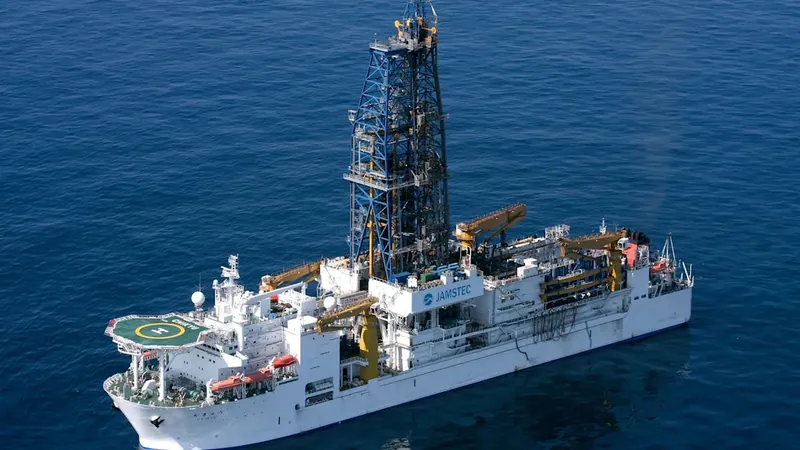
Unearthing Secrets of Mega-Earthquakes: The Deep-Sea Expedition that Could Save Lives
2025-08-27
Author: Rajesh
Exploring the Depths of Disaster
Deep beneath the waves of the Japan Trench, seven kilometers below sea level, lies a treasure trove of insights into the most catastrophic earthquakes and tsunamis on our planet. In a groundbreaking mission known as Expedition 405, scientists embarked on a four-month journey from September to December 2024 aboard the Chikyu, the world’s largest scientific drilling vessel.
A Team of Expert Explorers
Sixty dedicated scientists, including sedimentologists, geochemists, and structural geologists, teamed up to delve into the ocean floor. Their mission? To retrieve sediment cores from a fault zone previously explored only once before, uncovering the mysteries behind these natural disasters.
Diving into History: The 2011 Mega-Earthquake
On March 11, 2011, Japan experienced a seismic nightmare as the Tōhoku mega-earthquake struck with a staggering magnitude of 9.1. This disaster wasn’t just a world record breaker—it was a humanitarian tragedy, claiming over 18,000 lives and causing extensive damage, including the Fukushima nuclear disaster that led to estimated losses of $235 billion.
Scientists were left astounded not only by the earthquake's sheer strength but also by its mysterious trigger: an unexpected rupture under the sea floor rather than several kilometers deep, dispelling previous assumptions about how these geological giants operated.
Drilling Deep for Answers
Expedition 405 ventured straight into the heart of the fault that unleashed the 2011 quake, drilling more than 800 meters beneath the sea floor at the very zone where the disaster occurred. This deep dive aimed to shed light on what conditions allow such destructive tsunamis to form.
Revealing Earth's Secrets Through Cores
Onboard the Chikyu, operations were relentless, with new sediment cores arriving every three hours—each one a layered record of the Earth’s history. Scientists eagerly examined these cylindrical archives, searching for evidence of past geological upheavals.
One of the most exciting discoveries came when they unearthed chert, a hard, glassy rock that signifies a crucial geological boundary. This zone, known as the décollement, is where tectonic plates slide beneath each other, making it a perfect location for studying tsunami-generating earthquakes.
Monitoring the Future of Seismology
Pioneering further, the team established a long-term observatory that will monitor temperature and fluid pressure at the earthquake's source, allowing real-time insights into the fault’s dynamics. This is a rare opportunity in geoscience, offering a glimpse into how these faults transform over time.
Global Implications for Disaster Preparedness
The Japan Trench isn't an isolated case; similar subduction zones around the globe—from Chile to Indonesia—pose potential threats to densely populated coastal regions. It’s essential to rethink preparedness strategies in light of findings that shallow slips can trigger massive earthquakes.
Ultimately, the goal of Expedition 405 is not just about understanding the past but actively contributing to future disaster preparedness and resilience. By enriching our knowledge of mega-earthquake behavior, scientists aim to bolster tsunami hazard assessments globally.
A Milestone in Earthquake Science
As this ambitious expedition concludes, the ensuing data gathered will offer unprecedented insights into fault evolution—paving the way for better anticipation and mitigation of future seismic events. This exploration marks a significant milestone, empowering communities worldwide to face the threat of mega-earthquakes more proactively.




 Brasil (PT)
Brasil (PT)
 Canada (EN)
Canada (EN)
 Chile (ES)
Chile (ES)
 Česko (CS)
Česko (CS)
 대한민국 (KO)
대한민국 (KO)
 España (ES)
España (ES)
 France (FR)
France (FR)
 Hong Kong (EN)
Hong Kong (EN)
 Italia (IT)
Italia (IT)
 日本 (JA)
日本 (JA)
 Magyarország (HU)
Magyarország (HU)
 Norge (NO)
Norge (NO)
 Polska (PL)
Polska (PL)
 Schweiz (DE)
Schweiz (DE)
 Singapore (EN)
Singapore (EN)
 Sverige (SV)
Sverige (SV)
 Suomi (FI)
Suomi (FI)
 Türkiye (TR)
Türkiye (TR)
 الإمارات العربية المتحدة (AR)
الإمارات العربية المتحدة (AR)